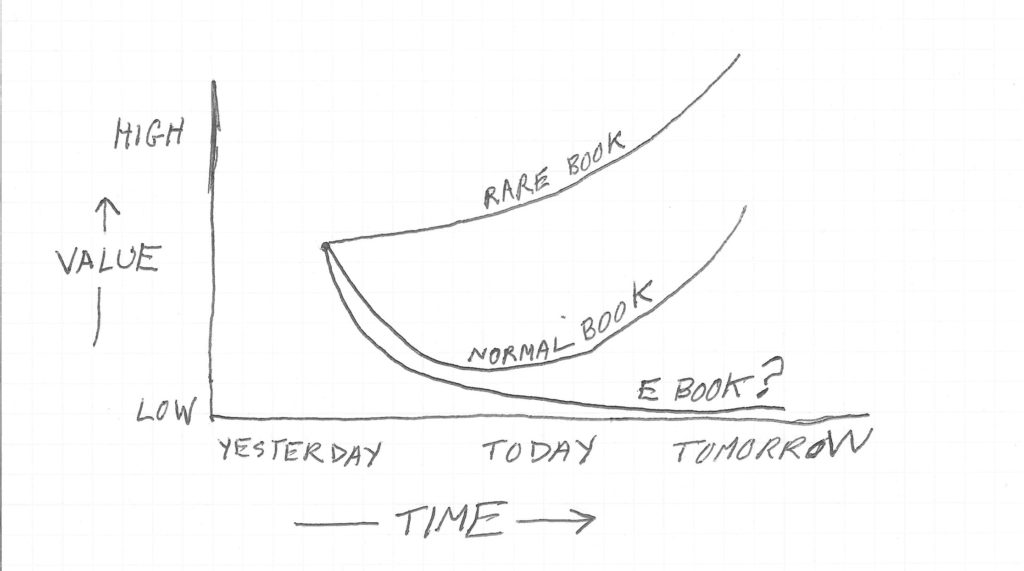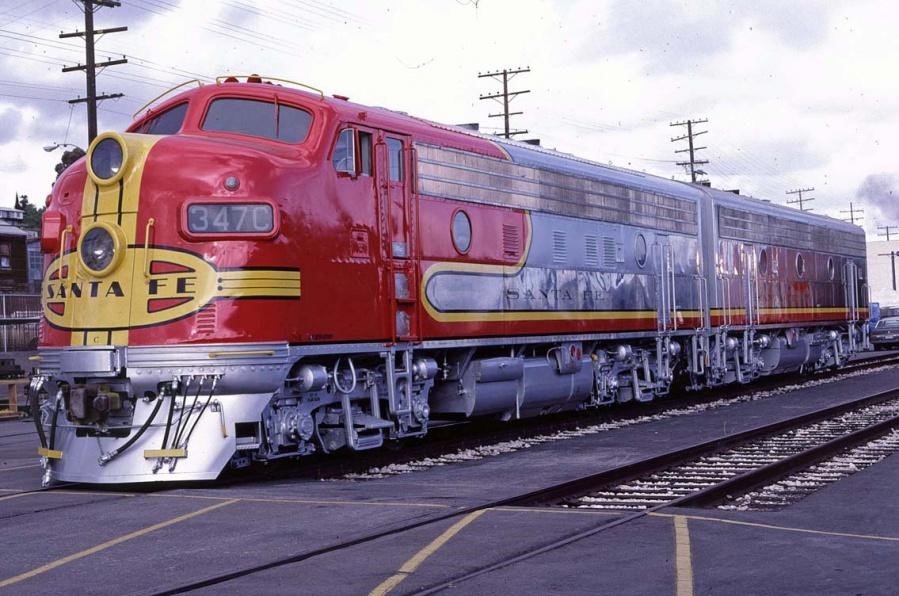Today virtually all forms of traditional media are under siege. The way we acquire and use movies, “records,” books, magazines, newspapers, radio, and television have all been transformed, with more dramatic changes predicted. At the same time, old media has not gone away, and many of us love old media. You may have an old book or vinyl album. You may remember the time you got it, who gave it to you, or from whom you inherited it. As a lifelong book collector, I sometimes ask myself, what is it worth? What will it be worth in the future? What factors will determine that value?
The world is filled with libraries, archives, and personal collections of old media. And plenty of dealers in it, like New York’s Strand Bookstore, many used record and vinyl stores, and the great bookstore chain Half Price Books. The long-term value of this media matters to all of them.
Drivers of Value
The most important determinant of value is supply and demand. However, given that the older items are no longer being produced, supply takes on a special role. Nothing is more important than scarcity. I have long said my favorite book is the World Almanac, which I started buying annually in 1959, at the age of eight. Since that was one of the best selling books of its era, millions were printed, and it may never be worth much. An equally important question is “how many were thrown away?” Old Yellow Pages phone directories, one of the best ways to study the history of commerce, were printed by the tens of millions but are now rare and expensive.
The demand side can be more unpredictable and cyclical, as things go in and out of fashion. Twenty years ago, collectors loved mid-fifties Chevies, and the values were shooting up. But you could buy the less popular 1950s Chrysler models cheaply. Today all those cars are worth a mint if they are restored or in good original shape. Similar patterns can be found in the value of old media, as artists, authors, and film genres are in (or out) of vogue.
Nostalgia
The value of aging products over time is fascinating. Like many kids, I fell in love with trains. Steam engines were largely phased out about the time I was born. So my favorite trains were big, beautiful diesel-electric locomotives. But when I went into hobby shops to buy books and models, they were hard to find. Railroad memorabilia collectors tend to be old men, and at that time they had no use for the newfangled engines which replaced their beloved steam locomotives. Then I noticed, as the decades went by, my generation took over, and we cherished the diesels. Thousands of books and models became available. So there is a time lag between the introduction of a new idea or technology and nostalgia and collecting.

This realization led me to believe that there was a great future in airline collectibles. In the 1970s, the industry was still too young to have many collectors. I had a collection as a kid and in the 1980s started adding to it, until the prices got too high. I believe there was one airline collectible trade show in the US back then; today there are dozens worldwide, and an active community, largely consisting of retired airline employees, a number which has grown dramatically.
Add on top of this that most young people do not have much nostalgia or much to be nostalgic about, with few exceptions. Nostalgia however grows with age. When I first attended my high school reunions, half the class didn’t show up – I suppose some thought, “Why would you want to see those people again?” But as the years went by, more and more returned. One reunion in my hometown drew almost every surviving graduate – at age 90! They were probably all “scrapbookers” by then.
With an aging population in the US, Europe, and Japan – all full of collectors – the demand for the right stuff will only grow. What happens when these generations die off is still an open question.
In my pursuit of understanding these patterns, I once charted the current value of a Chevy from every year since they began production in 1913. I found that the cars were most valuable when they were new or when they were very old, with the low point at age 20. Prices over time formed a u-shaped curve, with high values early and late, sagging in the middle.

Music and Electronics
Early in the age of the personal computer and its descendants, I realized that computers would move beyond being “just office machines” used for typing and calculations. Pioneers using the Commodore Amiga computer began pressing the idea of “desktop video” while others pursued the creation of art and music. Clearly, this was going to be big!
At that time I also collected electronic synthesizers used to make music. I started out with a $100 cheapo from a pawnshop. It had been $400 new. Thirty years later, when retro analog gear was hot, I sold my cheapo for closer to $1000!
The creation of sound by musical instruments can be considered in three steps. First, we had acoustic instruments, from drums to flutes to violins. Some of these were handcrafted and valuable from early on: I doubt a Stradivarius violin had a slump at age 20 like those Chevies.
The next stage was the creation of music by electrical and electronic means, for which there are two main methods: sampling and synthesis. The Beatles used tape recordings of flute sounds, played on a device called a Mellotron, pictured below, inStrawberry Fields Forever. The Moody Blues made extensive use of it. This was the precursor of sampling, which uses real recorded sounds. Synthesis means using circuits and electronic components to create and shape sound waves, which are then sent out through the speakers. Bob Moog, John Chowning’s FM synthesis, and many others led the way. By the 1980s, beautiful full keyboard samplers and synthesizers were sold in music stores around the world at prices ranging from $1,000 to many thousands of dollars.

The third step came along when innovators realized that samplers and synthesizers were just computers with a piano-style keyboard, and if you plugged a USB keyboard into any computer, software should be able to take the place of those thousands of dollars worth of heavy equipment. Thus sprang up the virtual instrument industry, along with millions of downloadable samples to be used with sample playing software.
These advances have given greatly increased power to composers and performers, as well as hobbyists and experimenters like me – at much reduced cost. Most continue to mix all three types of instruments. What will their value be in 5 years, 10, or 20? Here is my hand-drawn chart of what I think is likely to happen, subject to patterns of supply and demand for each specific item:

These are very different patterns. In most fields, five to ten year old software is among the least valuable things on earth. Will that ever change?
Back to Books
I believe books have a similar structure, and likely much of the other “old stuff” in our lives. (There are collectors of everything imaginable, including for example many collectors of dolls, toys, games, china, glass, militaria, and Coca-Cola collectibles. Collecting is not just for stamps and coins anymore!)

The Role of Art and Touch
In thinking through the future value of these and other items, two more factors come to mind: art and touch.
I started subscribing to Fortune magazine at age 12 and Forbes at 13. I have put together an almost complete collection of Fortunes going back to their 1930 startup. But trying to find old issues of Forbes is almost impossible, despite the fact it is an older magazine with great information value. Why? Because Fortune was in many ways an art publication under founder Henry Luce, and every cover was a work of art. The most valuable issues have cigar labels bound into them for an article about the then-big cigar industry. The Forbes all went out in the trash. The earlier System, the management magazine of its era, is very difficult to find.
How you want to use the old item, how functional it is, is another factor. There are some architecture books where the original sells for $3000 but a nice reprint is only $50. If it is the information I want, and I don’t care about “art,” I would much rather have the reprint.
Cuba is famous for its 1950s American cars, tens of thousands of them. But if you watch the documentary about those cars, you realize that most of those drivers would give their right arm to have a new functioning Toyota or Kia! To an American collector, the old ones are works of art, ready for investment in restoration.
The other factor is tactile – what does it feel like? A kindle does not feel or smell like a big world atlas sitting in my lap. An iTunes download does not match an album jacket with liner notes. A virtual instrument on a computer can only mimic the knobs, sliders, dials, and switches of an old school synthesizer. I believe that in many cases, the old school systems are much faster and more efficient. On my blog, I talked about why Google and other maps just do not work as well as foldout paper maps. In the time since I wrote that blog, the problems with online maps have gotten worse in my experience – in the last week I experienced another nonexistent road in the Google system.
The Future
As new generations come along, those who never read a World Almanac with a flashlight under the sheets after bedtime, or never owned a cassette tape, they will have different levels of affection for this old stuff. At least a few will begin to collect – there will be plenty available when the baby boom dies off. But others may just see them as expensive, outdated, space-consuming, useless trash. (Not unlike my mother when it came to old Mickey Mouse watches and Yellow Pages after my siblings and I left the house.)
As to books, the love of my life, I believe they will continue to be printed in large quantities long after I am gone. However, given the explosion in information and entertainment media, of which books are a part, their “market share” will decline dramatically. If for example book production were to remain flat for years, books’ share of information might drop by 70-90% over time.
We should also remember that technology is not linear; it bobs and weaves. Fax machines were available but rare for many years before every household seemed to have one, and now they are gone again. The Apple Newton bombed but the iPad took off. We had a totally wireless US television content distribution system but replaced it with a wired (cable) system, which in many fields would be seen as moving backwards.
Even when the tide is out, the waves still continue to come back toward shore. Even in the age of iTunes, vinyl albums are as strong as ever, and some firms are even making luxury CDs. Mass market fiction may move to eBooks, but creative publishers and individuals will make customized, personalized, specialized, and beautiful books of great value.
Perhaps the only thing I am confident of is that Half Price Books will live on for a long time. There will always be collectors and there will always be closets and warehouses full of old stuff to be bought and sold.
Gary Hoover











